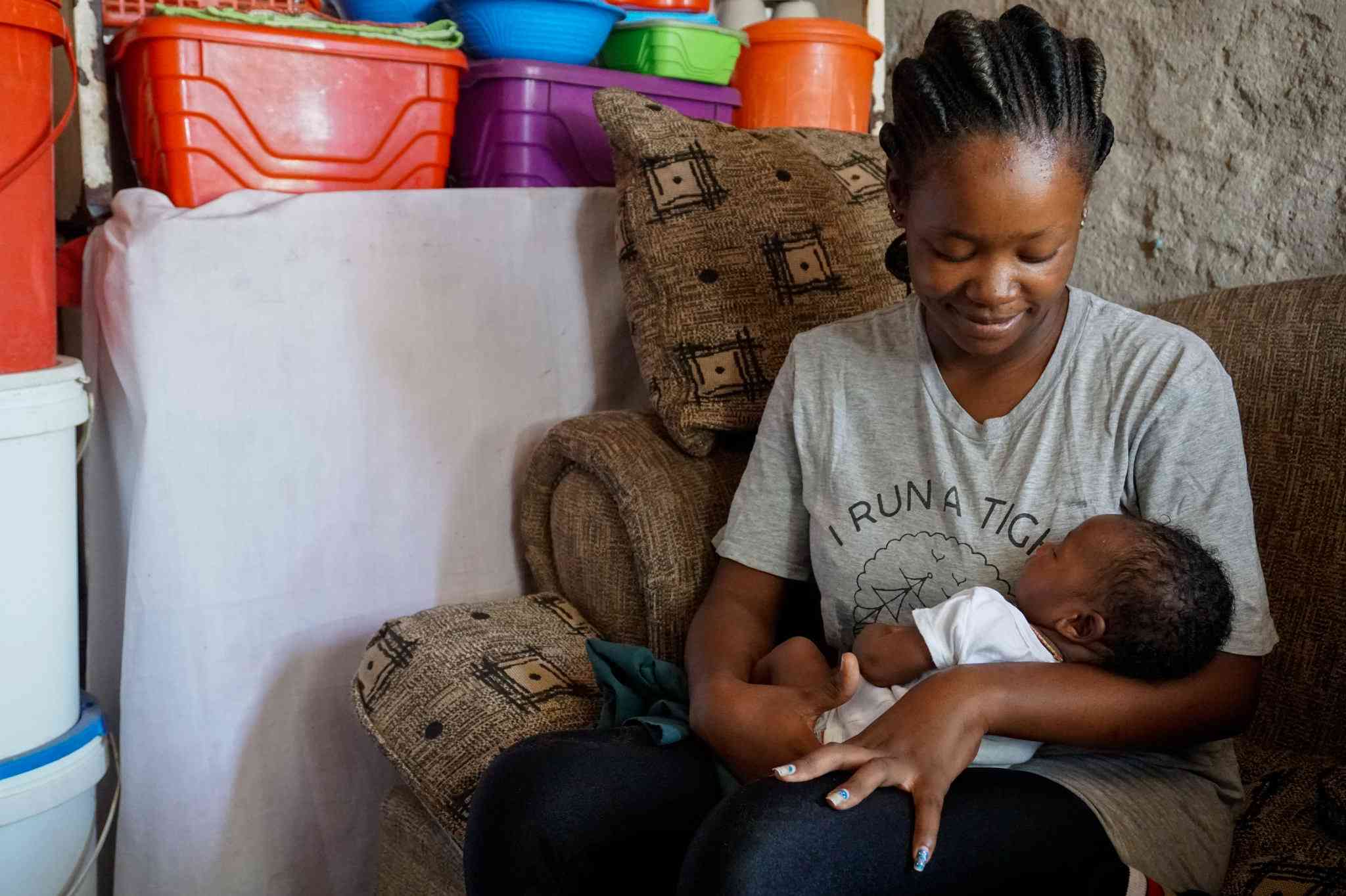
HARARE, ZIMBABWE — In the high-density suburb of Hopley, Tatenda Mangwanya, 16, admires her 2-week-old baby girl to whom she gave birth with the assistance of a self-trained midwife.
She stands by her decision to give birth at home, which she says was the safest for her baby, whom she named Nqobile, a Ndebele name meaning “victor.”
“I was registered at a local clinic in the neighboring suburb of Highfield about 10 kilometers from here, but I was transferred to [the hospital] located farther away from my home because I was underage,” Mangwanya explains.
In Zimbabwe, local health clinics employ midwives who assist women with natural births. But women with riskier pregnancies — such as those who are underage and pregnant for the first time — are advised to give birth at a hospital.
“I would go to the hospital for the usual monthly checkups and hear so many stories about women getting operated on unnecessarily and ill-treated by nurses that I was scared,” Mangwanya says.
When it was time to give birth, Mangwanya decided to seek assistance from a local spiritual healer.
Many reasons lead Zimbabwean women like her to give birth in their homes or at church shrines, including the cost of public clinics, long distances to health care facilities and a general belief that they are afforded better service at these sites than at hospitals.
However, medical experts interviewed for this article say such births are often conducted under unsafe conditions by untrained people, putting both the mother and baby at risk.
- Symptoms of toxicity at workplaces
- The Fiddler: Your days are numbered
- The Fiddler: Your days are numbered
- Sista2Sista programme saving women: Saving communities
Keep Reading
At 363 deaths per 100,000 live births, Zimbabwe’s maternal death rate is considered moderate to high, according to a classification system developed by the World Health Organization. Another 32 of Africa’s 54 countries also have moderate-to-high maternal death rates, according to a 2023 report by Zimbabwe Coalition on Debt and Development, a nongovernmental organization that advocates for citizen involvement in public policy.
Zimbabwe is far from achieving the United Nations’ sustainable development goal of lowering the maternal death rate to 70 or fewer per 100,000 live births by 2030 — especially in light of the health sector’s brain drain. Zimbabwe is currently grappling with a deficit of nearly 30,000 health professionals. Almost 4,500 medical professionals have left the country since 2020, mostly seeking better-paid employment abroad.
Apolonia Takaedza, who helped Mangwanya deliver her baby, practices midwifery out of her house in Hopley. In Zimbabwe’s public hospitals, it’s common for pregnant women to be asked to provide such supplies as gloves and cotton wool at the time of delivery — and that tends to push people away, she says.
“Some don’t have money or even proper clothing for the baby. … When one is giving birth at the hospital, they are required to buy [these items that] they cannot afford,” she says.
Free maternity care used to be available in Zimbabwe through a program tied to the World Bank, but lack of supplies has led hospitals to increasingly charge patients.
Takaedza adds that some women have beliefs that are not recognized at hospitals, including that vaginal growths lead to infertility or miscarriage, and they prefer to be treated by someone who takes these concerns seriously. She also mentions fear of cesarean sections. “Some choose to give birth at home to avoid being operated. At home, they are guaranteed a normal delivery.”
Takaedza charges 25 United States dollars for her midwife service, the same fee charged for a natural delivery at the nearest local clinic. “It’s always negotiable and payable in installments, and that’s why some prefer my service,” she says.
But she has faced difficult situations which may have been better handled at a hospital.
“A friend who also assists women to give birth came with a woman to me after failing to help her deliver. The baby had already died in the womb,” Takaedza says.
To guard against such occurrences, Takaedza says, she always does an assessment before agreeing to help someone deliver. “Some have children in breach positions and some situations need the hospital.”
Dr. Mugove Madziyire, an obstetrician, says there are many risks associated with home deliveries. “Any person supervising labor and conducting deliveries must be trained and certified by a responsible authority.”
He adds that labor and delivery can present complications during and after birth.
“There are also medications to be administered to both mother and baby at the time of delivery which prevent complications, such as excessive bleeding from the mother, bleeding disorders in the baby, and eye infections,” he says.
Donald Mujiri, spokesperson for the Ministry of Health and Child Care, says registered nurses with a minimum of three years of experience are eligible for a free, one-year training in midwifery offered through the ministry. These trained midwives are eligible for employment in local clinics that perform natural births.
A few kilometers from Takaedza’s residence, Hilda, a member of an apostolic sect, also assists women giving childbirth from her home. Unlike Takaedza, Hilda — who asked to be identified only by her first name as her sect doesn’t allow members to speak to the press — has a waiting shelter for such women; they usually stay at her house from about seven months of pregnancy.
Inside Hilda’s makeshift delivery room, walled with plastic and lined with grass, a young mother smiles as she holds her newborn baby boy, delivered the previous night. Other pregnant women, also members of the same church, gather around her, congratulating her as they each wait for the day they will deliver.
Outside, smaller makeshift rooms house 24 other pregnant women, waiting to deliver their babies.
Hilda does not have any medical qualifications — only her practical experience. The 51-year-old says she started to help women from her church give birth when she was 36, after experiencing a “calling” to do this kind of work.
“I have given assistance to over 400 women. As a rule in our church, we do not go to the hospital for deliveries,” she says.
Hilda says that in 15 years of practice, she has never once had to rush a woman to a hospital. “We do face challenges, but I always get a voice that speaks to me and instructs me on how to deal with each and every situation,” she says.
She adds she also doesn’t use gloves when performing the procedures, “as per church doctrine.” Members of this church are known for distrusting medical practice and vaccines.
Dr. Lucia Gondongwe, deputy director of reproductive health at the Ministry of Health and Child Care, says the ministry upholds institutional deliveries as the standard of care. “This enables women to get a comprehensive package of care required for childbirth and the newborn,” she says, adding that it ensures both the mother and baby get emergency assistance if it’s needed.
But Edinah Masiyiwa, executive director of Women’s Action Group, an NGO that advocates for women’s rights, says that institutional health care has only worsened during the broader economic decline.
“We are in a situation where the public system is requesting women to bring everything needed for their care — things like pads, methylated spirit, cord clamps,” she says. “If there is need for a transfusion, women have to buy the blood, which is more than 100 [US] dollars. If there is need for antibiotics, they also have to buy.”
Madziyire, the obstetrician, agrees the charges are an issue. “Making the facilities fully equipped and stocked will encourage women to utilize them. Staff must be well motivated so that they handle patients well.”
Beatrice Zindora, a resident of Hopley, says she assists women in dire situations to deliver their babies. Many are not registered at local clinics and hospitals, and some do not have baby supplies, such as clothes and diapers.
“We are in a situation where the public system is requesting women to bring everything needed for their care — things like pads, methylated spirit, cord clamps.”
EDINAH MASIYIWA
WOMEN’S ACTION GROUP
“I do this for free and out of my desire to help women,” Zindora says.
A few days earlier, she says, a woman came who could not walk or talk because she was in so much pain. The baby was coming legs first. “I had to insert my hands inside the woman to bring the baby outside. The baby did not cry for a moment and I was panicking, but later he cried. After the birth of the child, I encouraged them to visit the hospital.”
A year ago, Magnus Kundanai gave birth at a church shrine because it was too late for her to go to the nearest clinic and she could not afford the transport — despite the fact that she had already paid 25 US dollars in advance to give birth at the clinic, which took her three months to raise. “Such an amount is hard to earn.”
Madziyire suggests that the Ministry of Health and Child Care train and certify the attendants at the shrines and also inspect and certify the independent facilities used for delivery.
Gondongwe says the ministry is working to expand health facilities. “It is the ministry’s desire that everyone is within a 10-kilometer radius of a health facility, and it has been working towards the achievement of this mission. However, there are some hard-to-reach communities which had not realized this target.”
But for young mothers like Mangwanya, home births are still preferable.
“After being treated well at the shrine, if the health care system does not improve, I am likely to return to Takaedza for assistance,” she says with a smile.
- This story was originally published by Global Press Journal https://globalpressjournal.com/africa/zimbabwe/inside-makeshift-maternity-wards-harare/
- Global Press Journal is an award-winning international non-profit news publication that employs local women reporters in more than 40 independent news bureaus across Africa, Asia and Latin America.









